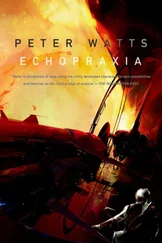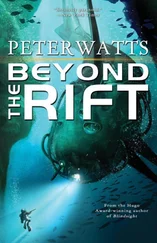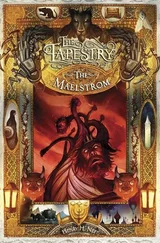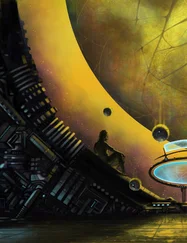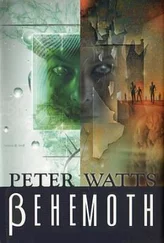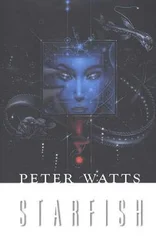A related premise is that lineages with genetically-determined behavior would be able to pass a Turing test if they evolved fast enough. This won't be hard to swallow for anyone familiar with how sophisticated such behaviour can be; we do, after all, live in a world where ants practice animal husbandry, birds follow orthodome routes to navigate halfway around the world, and honeybees convey sophisticated travel instructions by wiggling their asses at each other. Skeptics might want to read any of E. O. Wilson's books on sociobiology, or an old Scientific American article by John Holland [30] Holland, J. H. 1992. Genetic algorithms. Scientific American, 267(1): 66–72.
. It's way out of date, but it clearly conveys the principals behind genetic algorithms.
Finally, anyone who treats the phrase "group selection" as an obscenity (I admit they're right, most of the time) might first want to check out D.S. Wilson's review article of the subject in Skeptic [31] Wilson, D.S. 2000. Nonzero and nonsense: group selection, nonzerosumness, and the Human Gaia Hypothesis. Skeptic 8(1): 84–89.
Smart Gels
Research on the construction of thinking meat has proceeded apace since Starfish came out. Recent research is thumbnailed in "Neurons and silicon get intimate", by Robert "no-not- that -Robert" Service [32] Service, R. 1999. Neurons and silicon get intimate. Science 284: 578–579.
. More conventional neural nets are literally in the driver's seat: Carnegie Mellon's ALVINN program (which I mentioned briefly in the references to Starfish ) has now moved moved onto the highway, where neural nets have autonomously taken ninety-mile jaunts on public highways, at speeds up to 70mph. They learned to drive by watching people at the same task. It took them less than five minutes.
We still can’t be sure exactly what neural nets actually learn when we train them. Paradigm cock-ups of the sort that made my "head cheeses" betray their masters have happened in real life. One infamous military neural net taught itself to distinguish between various ambient light conditions, while all along its humans thought they were teaching it to recognize tanks [33] Episode four of the PBS video series "The Machine that Changed the World": Go to http://www.otterbein.edu/home/fac/dvdjstck/CSC100/CSC100TMTCTW.htm* * *TM for farther information.
.
Ganzfeld Interrogation
Back in Starfish I cited Roger Penrose's quantum-consciousness theory to justify the rudimentary psi-powers of the rifters. Here in Maelstrom Lubin uses the same trick to interrogate Achilles Desjardins. In the interest of full disclosure I should admit that Penrose's theory has come under serious attack from a guy called Tegmark [34] Tegmark, M. 2000. The importance of quantum decoherence in brain processes. Physical Review E 61: 4194–4206.
: the quantum-mind afficionados have rallied [35] Quantum computation in the brain? Decoherence and biological feasibility", abstract of a talk given at the 2000 Tucson Conference by the University of Arizona's Center for Consciousness Studies (available online at http://www.consciousness.arizona.edu/hameroff/decoherence.html* * *Abstract)
, but things may be looking a bit iffier on the quantum-consciousness front these days. What can you do.
Haunted by Happiness
Lenie Clarke's «hallucinations» are loosely based on Bonnet's Syndrome [36] Teunisse et al . 1996. Visual hallucinations in psychologically normal people: Charles Bonnet's syndrome. Lancet 347: 794–797.
, a malady which sometimes results from macular degeneration. The brain really does compensate for loss of visual input by inserting images from visual memory into the gaps. In real life, Bonnet's Syndrome tends to occur in elderly patients, and is frequently associated with bereavement; the hallucinations are more-or-less seamlessly incorporated into the visual environment (as opposed to the picture-in-picture format Lenie experienced).
Finally…
If you want a more luminous taste of all this stuff, check out my Rifter website. It's at www.rifters.com
1 Unwins, P.J.R. et al. 1998. Novel nano-organisms from Australian sandstones. American Minerologist 83: 1541–1550.
2 Broad, W.J. 2000. Scientists find smallest form of life, if it lives. NY Times , Jan. 18.
3 Euzéby, J.P. March 2001. List of bacterial names with standing in nomenclature. http://www.bacterio.cict.fr/index.html
4 Kajander, E.O., et al. 1999. Suggestions from observations on nanobacteria isolated from blood. In Size Limits of Very Small Microorganisms: Proceedings of a Workshop. National Academy Press, Washington. 164 pp.
5 Kroes et al. 1999. Bacterial diversity within the human subgingival crevice. Proceedings of the National Academy of Sciences of the United States of America 796(25): 14547-14552.
6 Rainy, P.B., and E.R. Moxon. 2000. When being hyper keeps you fit. Science 288: 1186–1188.
7 Blachford, A. 1984. Metavariation and long term evolutionary patterns. M.Sc. thesis, Zoology, University of British Columbia, 140pp.
8 Marsh, M., and H.T. McMahon. 1999. The structural era of endocytosis. Science 285(5425): 215–220.
9 Decatur, A.L., and D.A. Portnoy. 2000. A PEST-like sequence in Listeriolysin O essential for Listeria monocytogenes pathogenicity. Science 290: 992–995.
10 Eschenmoser, A. 1999. Chemical etiology of nucleic acid structure. Science 284: 2118–2123.
11 Gesteland, R.F., et al. 1999. The RNA World. Cold Spring Harbor Laboratory Press, Cold Spring Harbor, NY. 735pp.
12 Gray, M.W., et al. 1999. Mitochondrial Evolution. Science 283: 1476–1481.
13 Orgel, L. 2000. A simpler nucleic acid. Science 290:1306–1307.
14 Orgel, L. and L. Ost. 1999. Did life originate in an RNA world? In Size Limits of Very Small Microorganisms: Proceedings of a Workshop. National Academy Press, Washington. 164 pp.
15 Vogel, G. 1998. Finding life's limits. Science 282: 1399.
16 Rasmussen, B. 2000. Filamentous microfossils in a 3,235-million-year-old volcanogenic massive sulphide deposit. Nature 405: 676–679.
17 Lodish, H., et al. 1995. Molecular Cell Biology, 3 rded. Scientific American Books, W.H. Freeman & Co., NY. 1344pp.
18 Schulz, H.N., et al. 1999. Dense populations of a giant sulfur bacterium in Namibian shelf sediments. Science 284: 493–495.
19 Macmillan, M. 2000. An Odd Kind of Fame Stories: of Phineas Gage. MIT Press, Cambridge, MA, 576pp.
20 Anderson, S.W. et al. 1999. Impairment of social and moral behavior related to early damage in human prefrontal cortex. Nature Neuroscience 2: 1032–1037.
21 Davidson, R.J., et al. 2000. Dysfunction in the neural circuitry of emotion regulation—a possible prelude to violence. Science 289: 591–594.
22 Zimmer, C. August 2000. Do parasites rule the world? Discover : 80–85.
23 Zimmer, C. 2000. Parasites make Scaredy-rats foolhardy. Science 289: 525–527.
24 John Rennie, J. January, 1992. Living Together. Scientific American .
25 Huberman, B.A., and R.M. Lukose. 1997. Social Dilemmas and Internet Congestion. Science 277: 535–537.
26 Matrix-net's Internet Weather Report, at http://www.mids.org/weather/.
27 Barabasi, A.-L. et al. 1999. Internet: Diameter of the World-Wide Web. Nature 401: 130–131.
28 Parrish, J.K., and Edelstein-Keshet, L. 1999. Complexity, Pattern, and Evolutionary Trade-offs in Animal Aggregation. Science 284: 99-101.
Читать дальше



